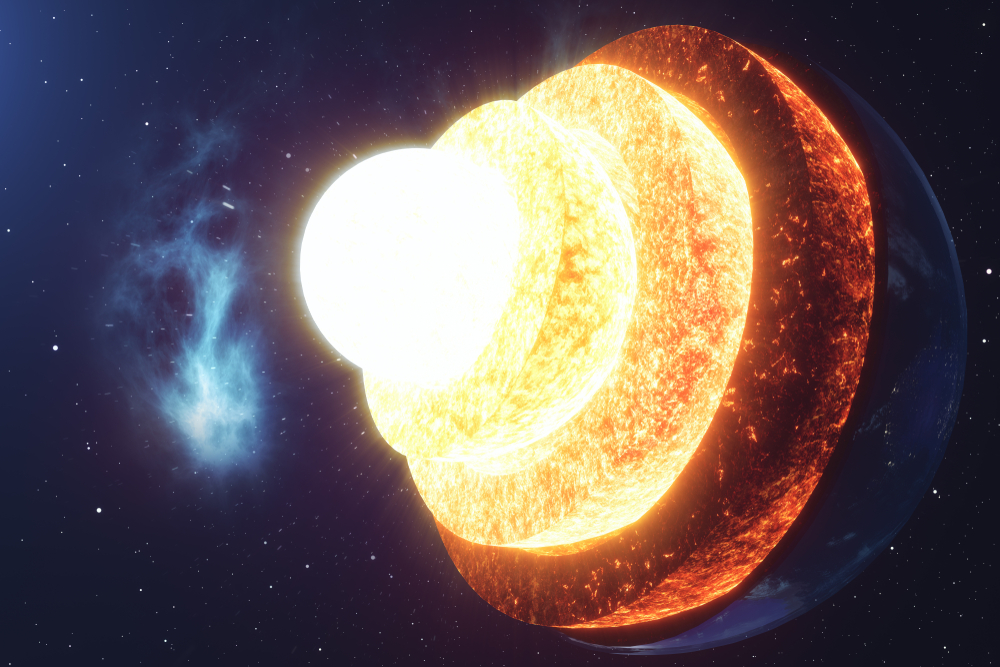The Last Day Of Life On Earth Has Been Calculated By NASA, This Is How Long We Have Left

The thought of Earth’s final day can feel distant, even unreal, but NASA’s recent predictions have calculated just how long we might have left. It’s a staggering number—one that doesn’t spell imminent doom for humanity—but it raises an urgent question: What kind of planet will we leave behind for the generations that come after us?
Our fragile, blue planet has supported life for billions of years, but it’s becoming evident that we’re testing its resilience. From soaring global temperatures to the rapid melting of polar ice, the effects of climate change are more tangible by the day.
This journey isn’t about far-off science fiction or abstract doom—it’s about the real, tangible steps we can take right now to protect the planet. Because while the timeline for Earth’s last day stretches into the distant future, the countdown to creating a healthier, more sustainable world has already begun. And it starts with us.
 Image source: Shutterstock
Image source: Shutterstock
NASA’s Prediction – What the Future Holds
NASA’s projections have offered a glimpse into a future that may seem incomprehensible. Using advanced simulations, they estimate that Earth has roughly 1 billion years left before conditions become too extreme for life as we know it. This staggering number may be a relief, but it also serves as a profound reminder: Earth is not immortal, and neither are we. While the end of life on Earth is far beyond our own lifetimes, the choices we make today are already shaping the distant future.
At the core of this grim prediction is the process of deoxygenation—the slow but steady reduction of oxygen in Earth’s atmosphere. This phenomenon, which could render the planet inhospitable, is linked to various factors such as oceanic changes and disruptions in microbial life that produce oxygen. Though this event is projected to occur in the distant future, it underscores the delicate balance required to sustain life on Earth. Already, human activities such as deforestation and pollution are causing disruptions to the planet’s oxygen-generating systems, giving us a glimpse of what unchecked environmental damage could eventually lead to.
While this scenario sounds like a distant nightmare, it is crucial to understand that the changes leading up to it are already unfolding. Human activities have accelerated environmental damage in ways that may not impact us directly but could create irreversible consequences for the planet over time. Deoxygenation may be a billion years away, but rising temperatures, extreme weather, and biodiversity loss are problems we cannot ignore.
What NASA’s predictions ultimately show us is the delicate balance that sustains life on Earth. It’s not just about the far-off future, but about how the present decisions we make—whether it’s reducing carbon emissions or protecting endangered ecosystems—will ripple through the ages. The fate of Earth isn’t set in stone, and while we may not prevent the final day entirely, we have the power to shape the quality of life for countless generations before that day arrives.
The Threat We Face Today: Global Warming and Environmental Crisis
While NASA’s billion-year timeline gives us plenty of breathing room, it doesn’t erase the very real threats we face today. Global warming is no longer a distant problem; it’s here, and it’s affecting every corner of the planet. From unprecedented wildfires to floods and droughts, the evidence of a warming world is all around us. Yet, we are still only beginning to understand the full scope of how these changes will shape our future.
The alarming reality is that global warming is accelerating faster than scientists initially predicted. As glaciers melt and sea levels rise, entire ecosystems are being disrupted. Wildlife that once thrived in stable climates now faces extinction. Meanwhile, human populations are grappling with the effects of extreme weather, which threatens food security, water resources, and infrastructure. The truth is, we’re no longer just fighting to protect the planet for future generations—we’re fighting to preserve it for ourselves, right now.
And it’s not just about melting ice caps or disappearing species. The bigger issue is the systemic crisis that connects everything from our carbon emissions to deforestation. Our planet’s health is intricately linked to human behavior, and every decision we make either pushes us further toward catastrophe or pulls us back from the brink. If we continue down this path, the damage to the planet will only become more severe, making it harder and harder to reverse course. The threat of extinction may seem far off, but the tipping point is already here.
 Image source: Shutterstock
Image source: Shutterstock
Environmental Mysteries: What We Don’t Know Yet (And What We Do)
Despite our technological advancements and our understanding of Earth’s climate systems, we are still faced with many unknowns about the future of our planet. NASA, with all its resources, has managed to project an eventual end to life on Earth, but even these calculations are not set in stone. The complexity of Earth’s ecosystems, combined with the unpredictability of human impact, makes predicting the future an elusive task. But this uncertainty is not a cause for despair—it’s a reason to stay curious and driven.
What we do know, however, is that our current trajectory is not sustainable. Scientists around the globe agree that unless we take immediate and substantial steps to reduce greenhouse gas emissions, the damage we are causing to our environment will be difficult, if not impossible, to reverse. While the exact details of Earth’s future may remain a mystery, the reality of climate change is all too clear. The floods, fires, and heat waves we experience today are only a small glimpse of what lies ahead if we continue to ignore the warnings.
This uncertainty also presents us with an opportunity—a chance to change the course of history. Just because we don’t have all the answers doesn’t mean we’re powerless. In fact, it means the opposite: we are in a position to innovate, adapt, and create new solutions to the environmental challenges we face. We may not be able to predict every outcome, but we can prepare for them by building resilience into our systems, protecting our natural resources, and committing to sustainability. The future is still being written, and we all have a role in shaping it.
Practical Ways to Reduce Your Environmental Impact
While the challenges we face may seem overwhelming, there are countless ways each of us can take action to reduce our environmental impact. These choices, no matter how small they seem, contribute to a collective effort that can drive significant change. Let’s explore some practical steps you can take to help make a difference:
Adopt a Plant-Based Diet
Reducing meat consumption, particularly red meat, is one of the most impactful ways to lower your carbon footprint. The production of beef and other livestock requires immense amounts of water, land, and energy, and it contributes heavily to greenhouse gas emissions. Even incorporating more plant-based meals into your weekly routine can significantly reduce your environmental impact.
Reduce, Reuse, and Recycle
The familiar mantra of “reduce, reuse, recycle” remains one of the most effective strategies for minimizing waste. By cutting down on single-use plastics, opting for products with less packaging, and reusing items whenever possible, you help conserve natural resources and decrease pollution. Recycling helps divert waste from landfills, but reducing consumption at the source is even more powerful.
Conserve Water
Water is a precious resource, and small changes in how we use it can have a big impact. Fixing leaky faucets, using water-saving appliances, and being mindful of water use in daily activities, like showering and washing dishes, can help preserve this vital resource. In regions where water scarcity is a growing concern, every drop saved counts.
Choose Sustainable Transportation
The way we get around has a major impact on the environment. Cars and trucks are among the largest contributors to carbon emissions, so choosing more sustainable options like biking, walking, carpooling, or using public transport can make a big difference. If possible, consider switching to an electric vehicle, which reduces emissions and helps decrease our reliance on fossil fuels.
Support Eco-Friendly Brands
Being a conscious consumer means supporting companies that prioritize sustainability. Look for products made from renewable resources, or those with certifications like Fair Trade or organic labeling. By choosing to spend your money on products that align with your values, you send a powerful message to businesses about what matters most.
 Image source: Shutterstock
Image source: Shutterstock
Renewable Energy: The Key to a Sustainable Future
As the world continues to grapple with the effects of climate change, one of the most promising solutions is the shift toward renewable energy. Fossil fuels have long powered our world, but they come with a heavy cost—pollution, habitat destruction, and global warming. The transition to clean, renewable energy sources like solar, wind, and hydropower is not just a technological advancement; it’s a necessity for the future of our planet.
Solar power, in particular, has seen tremendous growth in recent years. Thanks to advancements in technology and falling costs, solar panels have become more accessible to homeowners and businesses alike. Wind energy is another rapidly growing field, with large wind farms generating clean electricity in many parts of the world. Hydropower, though it requires significant infrastructure, is also a major player in the renewable energy space, offering a reliable and clean energy source.
But the benefits of renewable energy extend beyond environmental preservation. The growth of the renewable energy sector is creating jobs, boosting local economies, and driving innovation in technology. Countries that invest in clean energy are positioning themselves as leaders in the global economy, while simultaneously reducing their dependence on fossil fuels. The future of energy is clean, green, and sustainable—and the sooner we make this transition, the better our chances of curbing the worst effects of climate change.
Featured image source: Shutterstock
Loading...






